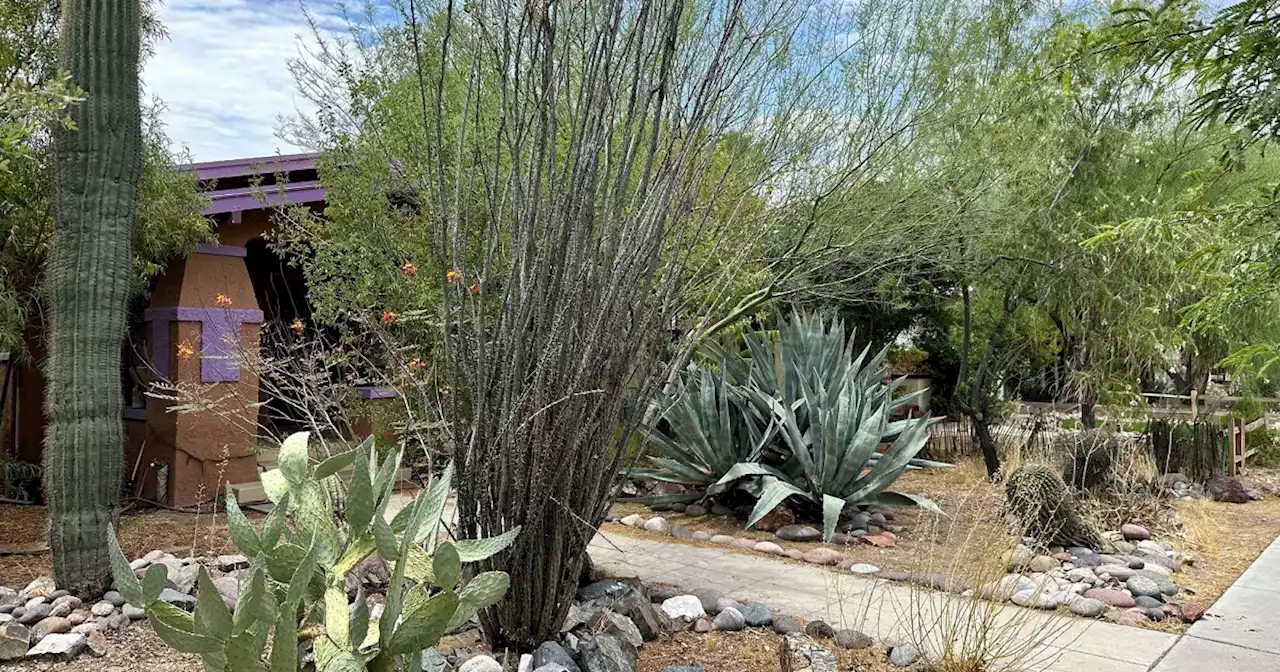Building urban infrastructure diverts stormwater from parking lots, streets and rooftops, which then captures it to grow trees and native vegetation in public parks, traffic circles and other public spaces, creating shade and natural habitats.
TUCSON, Ariz. — There are no lush green lawns among the rows of single-family homes that line a quiet boulevard a mile west of the University of Arizona campus. Instead, small lizards scurry across gravel to the shade of cacti, shrubs and trees native to the Southwestern desert, as cicadas drone and backyard chickens cluck in the triple-digit heat now common here in July.
All new commercial developments in the city must install mechanisms to capture stormwater from their roofs and parking lots for part of their landscaping. The city also offers rebates for existing commercial properties to add stormwater capture. Cities around Arizona already have begun collaborating on water treatment plants and sharing data to better allocate water resources in the region. There is no single solution or source that will solve the region’s long-term water security, local officials say. But a coordinated effort is underway to better adapt to a future with less Colorado River water.The Colorado River is in crisis, as the region suffers from two decades of drought — the worst megadrought in 1,200 years.
Because of the heavy rain and snow in the region this winter, Arizona and other Colorado River states have a bit of a reprieve in making heavy cuts before new federal rules go into effect after 2026. “The technology is safe and proven,” Peters said. “In this time of uncertainty for Arizona’s water supplies, this option can help bolster water resource portfolios for many communities.”Some cities aren’t waiting. Scottsdale, a city of 243,000 residents just northeast of Phoenix, has been recycling wastewater on a small scale, which so far has been used by local breweries. By 2026, city officials hope to use it widely in the community.
The tool, called the Central Arizona Water Clearinghouse, provides water supply and demand information, showing water infrastructure, communities’ capacity and the way they connect to other water infrastructure in the region. Ultimately, the tool can pair different communities’ needs with potential collaborators, she said.
Wastewater is a valuable resource that can now serve multiple communities through partnerships, said Nazario Prieto, the assistant water services director for Phoenix, which recently broke its record for most consecutive days with 110-degree or higher temperatures.
United States Latest News, United States Headlines
Similar News:You can also read news stories similar to this one that we have collected from other news sources.
 Former Tucson firefighter captain, convicted triple murder appears in courtTriple convicted killer and former Tucson Firefighter Captain David Dwayne Watson had a day in court Friday six years after sentencing.
Former Tucson firefighter captain, convicted triple murder appears in courtTriple convicted killer and former Tucson Firefighter Captain David Dwayne Watson had a day in court Friday six years after sentencing.
Read more »
 Tucson schools struggling to keep up with broken ACsAs the new academic year begins, there are more than 520 open maintenance tickets requesting air conditioning repair in Tucson schools. Nearly 400 of those were submitted in the last two weeks.
Tucson schools struggling to keep up with broken ACsAs the new academic year begins, there are more than 520 open maintenance tickets requesting air conditioning repair in Tucson schools. Nearly 400 of those were submitted in the last two weeks.
Read more »
 Tucson Speaks Out: Aug. 12 letters of the dayLetters to the Editor for Aug. 12
Tucson Speaks Out: Aug. 12 letters of the dayLetters to the Editor for Aug. 12
Read more »
 California man found dead on Tucson hike during extreme weather conditionsCalifornia man reported missing on a hike in Tucson has been found dead, authorities said Wednesday.
California man found dead on Tucson hike during extreme weather conditionsCalifornia man reported missing on a hike in Tucson has been found dead, authorities said Wednesday.
Read more »
 Woman shoots alleged intruder to death near TucsonA man was trying to break in to her home and ignored a warning shot before she fired again and struck him, the woman told the Pima County Sheriff's Department.
Woman shoots alleged intruder to death near TucsonA man was trying to break in to her home and ignored a warning shot before she fired again and struck him, the woman told the Pima County Sheriff's Department.
Read more »
 Interactive: How the economy is performing in Tucson and ArizonaIs our economy doing better or worse? See recent changes in local employment, regional inflation and more in these regularly updated charts and maps.
Interactive: How the economy is performing in Tucson and ArizonaIs our economy doing better or worse? See recent changes in local employment, regional inflation and more in these regularly updated charts and maps.
Read more »
